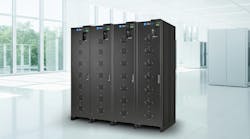The Future of the Data Center in the Internet of Everything
In this week’s Voices of the Industry, Rick Crutchley, Chief Operating Officer for IO, discusses the future of the data center and the internet of things (IOT).
Rick Crutchley, Chief Operating Officer, IO
Today’s data centers are complex systems tying together physical infrastructure to digital applications consumed on a daily basis. In essence, the data center houses the Internet of Everything (IoE).
Gartner predicts that more than 6.4 billion IP-connected objects in the Internet of Things (IoT) will be in use by 2016 and that number will rise to 20.8 billion things by 2020. That’s not counting laptops, tablets, and smartphones.
Some analysts put the number even higher, though less than the 50 billion devices often cited today.
But most of these devices won’t be consumer devices, they’ll be used in business—and mostly in healthcare to increase efficiency and effect patient outcomes as well as in manufacturing where they’ll be used to help manage the global supply chain. Today, in fact, computers smaller than a grain of sand can be injected into the body to diagnose disease or they can be sprayed on soil to measure chemical composition.
Where in IoT, devices are wirelessly connected to the Internet, in the IoE, these devices are connected to each other in a kind of machine-to-machine communication. There won’t be anything that we touch on a daily basis that won’t be connected to each other, which will drive greater interconnectedness and greater interdependency.
So with all of these devices talking to each other and producing limitless data, what will the data center of the future look like?
In the near short term, we talk about edge computing where instead of building mega data centers, smaller data centers could be built closer to where time-sensitive data requires immediate processing. For example, the location and mapping data on your smartphone might be processed at a nearby data center housed next to a power substation, while less time-sensitive data would be sent over the cloud to mega data centers for storage and analytics.
But beyond that, the interconnectedness of machines and devices will extend computational capability to wherever you are. In essence, the data center of the future will be everywhere.
Think of it this way: what is the largest machine that man has ever built? A colleague of mine suggests that that machine is the Internet because any machine that will be built, will connect to the Internet—from the smart controller inside your home to the rocket that journeys into space. The Internet will literally be everywhere.
So as our systems become increasingly transparent, the data center of the future will become increasingly simple. But it will lack all the things we cherish in resiliency today because they won’t require it. It might look just like any other utility that you drive past without noticing now.
Ephemeral applications and systems—those applications and systems that can be created and destroyed without any implications for their use—will also play into this simplified data center concept. Once that happens, the data center of the future will be diminished significantly from what it is today. The uninterruptible power supplies, generators, chillers, etc. of today will be used at a bare minimum in the future. Once ephemeral applications and systems have finished processing their data, they will be destroyed.
Data centers will also be manufactured like transformers, and the convergence of computational layer—memory, storage, CPU, and networks—will be housed within these boxes.
So the future of data center looks like large data lakes with massive concentrations of computational capability and persistent data. And there won’t be anything that we touch on a daily basis that won’t be connected or interconnected to each other.
Rick Crutchley serves as IO’s Managing Director of North America and is responsible for developing, managing and executing the Company’s sales strategy. Mr. Crutchley is a 16-year data center industry veteran, focused on building global sales teams, optimizing the customer experience and attaining annual sales and revenue targets. Upon joining IO in 2011, Crutchley was instrumental in providing best practices as business growth exceeded 30 percent year-over-year for three consecutive years.
Mr. Crutchley previously served as the Vice President of Global Sales for CoreLink Datacenters as well as the Chief Operating Officer for CyberTrails, a national provider of IT services. He was also the General Manager and Director of Western Operations for Inflow, which was acquired by SunGard in 2005. Mr. Crutchley is a board member of the Arizona Technology Council and Fresh Start Women’s Foundation. He is also actively involved in the CEO Forum and Arizona Business Leadership Association.


